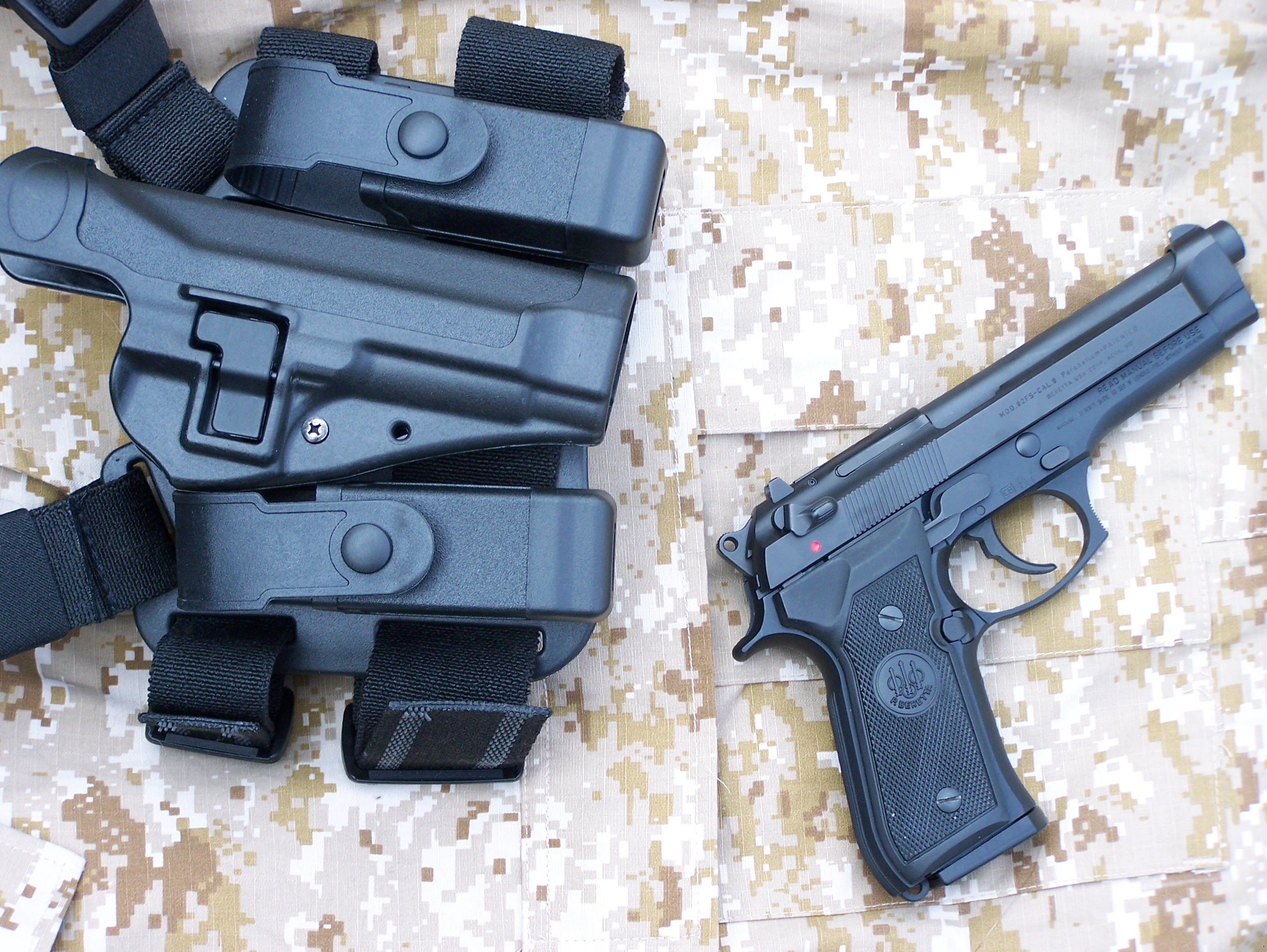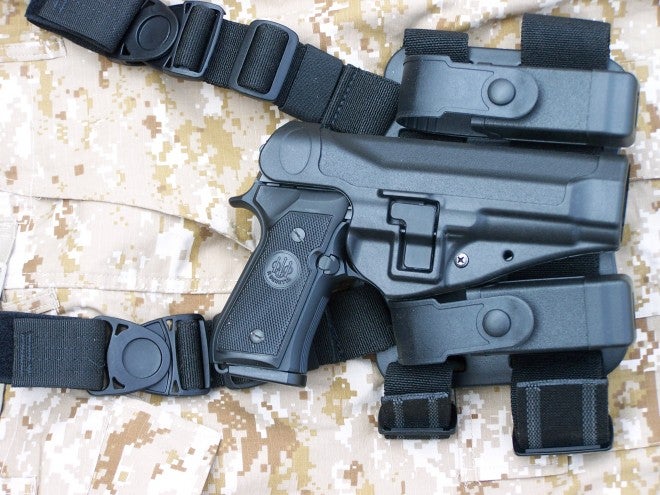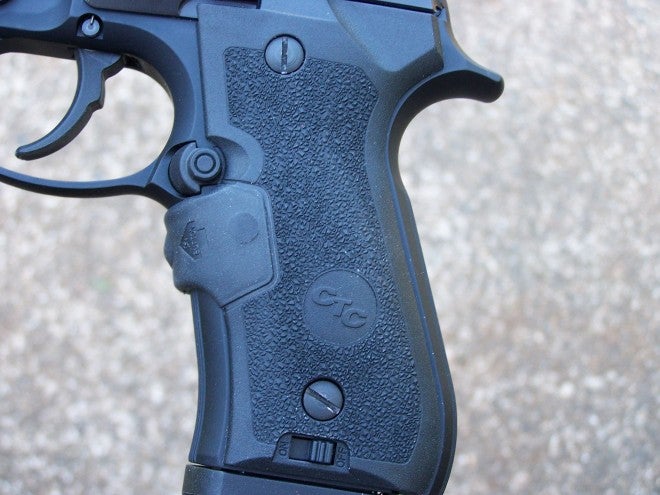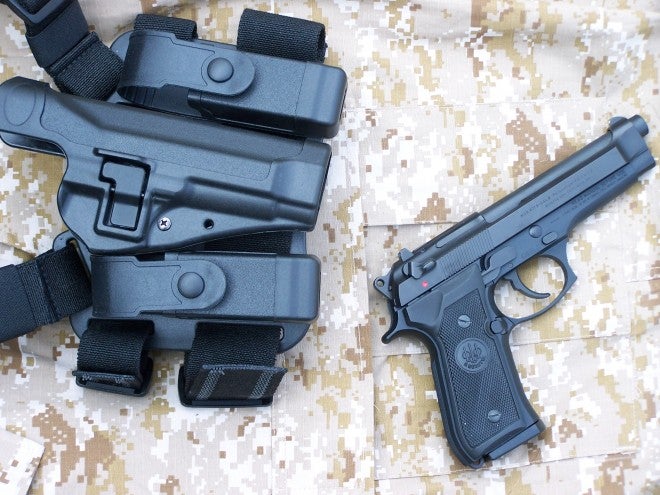Beretta Model 92FS
Pat Cascio 01.09.14

[contextly_auto_sidebar id=”oT0oNadvGdS4BVOI5m4p7r85YCpKPdxs”]
For those who don’t know, the Beretta M9 and M9A1 are issued to our military forces, with the A1 having an integral MIL-STD-1913 rail for mounting a laser or a light on the gun. The 9mm Beretta Model 92FS is also a popular handgun choice for consumers.
Since it was first announced in the 1980s that our military would be issuing some type of 9mm handgun, the 9mm round itself has been a source of contention with many shooters. Many claim the 9mm isn’t as good of a man stopper that the .45ACP is–and this is true, to a certain extent. Military forces are constrained, and can only fire 9mm FMJ ammo in their Beretta M9 handguns, as was true with the Colt 1911A1 .45ACP–it too was issued with FMJ ammo–and I believe most shooters will agree that. The larger .45ACP firing FMJ ammo is a better stopper than the 9mm firing FMJ ammo – however, the battle rages on, and will – for years to come.
When the 9mm round is loaded with a quality JHP round, in +P or +P+ ammo, it is right on the heels of the .45ACP loaded with JHP ammo, in terms of stopping a gunfight. Statistics prove this. However, I’m sure some will argue this point. But are all entitled to our opinions, and I base mine on stats over the years. Yes, the .45ACP is still a slightly better fight stopper–all things taken equally–but not by all that much; we’re talking on a few percentage points in real life.
There were some problems early on, when the US Military adopted the Beretta M9, in that, there were some instances where the slide broke off the frame and injured at least one shooter. The blame was placed on the gun. In the aftermath of the investigation, it was found that the rounds that were fired were in the proof load test range, meaning they were well above +P+ rounds, and no 9mm handgun will hold-up to constant firing of a proof load–no 9mm handgun! Still, to this day, many blame the Beretta M9 despite this.
There are several versions of the Beretta Model 92. The 92FS is almost identical to the military’s M9, in most respects, with the M9 having a slightly different rear sight set-up. The Model 92FS weighs in at 33.3-ounces, and has a 4.9-in. barrel, and it holds 15-rds of 9mm ammo. However, current issue guns come with three 17-rd magazines. The military still issues 15-rd magazines because that’s what the contract calls for. The 92 is a full-sized duty handgun. While it can be concealed, it wouldn’t be my first choice for a concealed carry handgun.
The 92 is a DA/SA handgun, in that the first round is normally fired from the double-action trigger pull, and subsequent rounds are fired single-action. There is also a decocker on the slide. Never mind what you’ve seen in the Die Hard movies, where the good guy places his thumb on the hammer and holds it while he pulls the trigger to release the hammer–that is not the way it’s done. You simply place a loaded magazine in the gun, chamber a round, and if you’re not going to fire the gun, you lower the decocker lever on the slide. The hammer safely drops the hammer, without the gun firing; you then push the decocker back up, and you are ready to fire your first round from the double-action mode.
The 92 has what Beretta calls a Bruniton finish on the gun. It is quite durable and holds up well to all kinds of weather conditions. The magazine release can be easily reversed from one side to the other if you are a left-hand shooter, too. Additionally, the Model 92 is easy to field-strip for cleaning; it only takes a few seconds to take the gun apart. The front sight is fixed, as is the rear sight, and I’ve yet to run across a 92 that didn’t shoot to point of aim at 25-yards with 115-gr ammo. The 92 is a very accurate handgun and it also has one of the smoothest DA trigger pulls I’ve ever run across. The trigger pull is long, but it’s very smooth.
During testing for the military, Beretta fired twelve Model 92 handguns at the Beretta USA plant, and fired 168,000 rounds without a single malfunction. During testing in 1984, for the military contract, the Beretta was the most reliable of all the pistols tested according to the Beretta website, and I have no reason to doubt this. I’ve never had a 92 or M9 malfunction on me. The average durability of the Beretta M9 slides is over 35,000 rounds, at which point, the US Army testing ceased. However, the military has protocol, and slide and barrels (and springs) are replaced at certain intervals. The average durability of the M9 frames is more than 30,000 rounds and the M9 locking blocks is 22,000 rounds, at which point they are replaced as a matter of routine. All guns wear out, at some point, so it’s prudent to replace certain parts, at certain intervals instead of waiting for those parts to fail.
When the US military adopted the Beretta Model 92FS, and renamed it the M9, police departments all over the country followed suit. And when the FBI adopts a new firearm and caliber, police departments jump on the bandwagon and copy what the FBI does. In reality, it saves large police departments from having to do their own endurance and accuracy testing–the guns adopted by the military and FBI have already been tested.
Over the years, I’ve owned several different variations of the Beretta Model 92FS, including the military version, the M9, which civilians can purchase, when they are available on the market. I’ve never had a 92 fail me, in any way, shape or form. I’ve carried a 92 concealed with the right holster and clothing, and I’ve carried a 92 while on-duty as a police officer and as a security officer when I had my own K9 patrol business. I had full confidence in the Model 92.
For this article, I tested my current Model 92FS, and I used the following 9mm ammo in my testing. From Black Hills Ammunition I had their 115-gr FMJ, 115-gr Barnes all-copper hollow point Tax-XP +P load, and their 100-gr Frangible load. From Buffalo Bore Ammunition, I had their 147-gr Subsonic JHP load, 115-gr Barnes all-copper hollow point, Tac-XP +P+ load, and their 124-gr Penetrator FMJ-FN +P+ load. I also fired some Winchester 115-gr FMJ ammo.
Now, a word of warning: all gun makers will tell you not to shoot +P+ ammo in their 9mm handguns, and they can give the lawyer mandated warnings all they want. In full-sized 9mm handguns, I don’t have any problems shooting +P+ ammo in limited shooting use. I don’t take any 9mm handgun out and fire thousands of rounds of +P+ ammo through it; it causes accelerated wear on a gun. And, in compact 9mm handguns, the slide is usually moving so fast that it fails to sometimes strip the next round from the magazine–so no +P+ in compact or sub compact 9mm for me.
In all, I fired slightly over 250-rds. All accuracy testing was done at 25-yards, over a rolled-up sleeping bag on the hood of my car. I had a limited amount of Black Hills 115-gr Barnes all-copper hollow point Tac-XP +P loads, for this test; however, this one proved to be the most accurate. I was getting groups slightly under 3-inches. All other loads tested were hovering in the 3-inch to 3 1/2in range, with the exception of the Black Hills 100-grain Frangible load–this was giving me 4-in. groups, still very acceptable combat accuracy. Many experts will agree that “combat accuracy” means getting 5-rds in a group of 3 to 4 in. The Beretta easily did that. I believe the gun is capable of doing better; my game isn’t always on, and during my shooting, we had a slight rain.
The Beretta M9 has proven itself over the years in two major conflicts (one in Afghanistan and one in Iraq) and many other skirmishes. The M9 and M92FS are highly reliable handguns, and with the right ammo, will get the job done for you if you do your part. If the M9/92FS is good enough for the military and numerous police departments, then it’s good enough for me.


